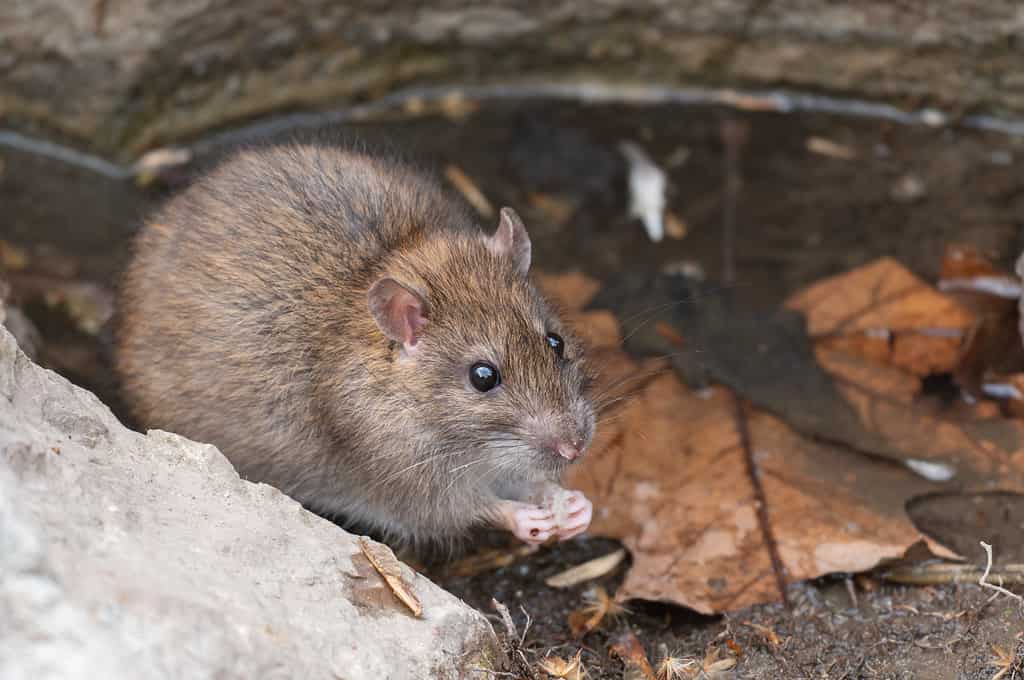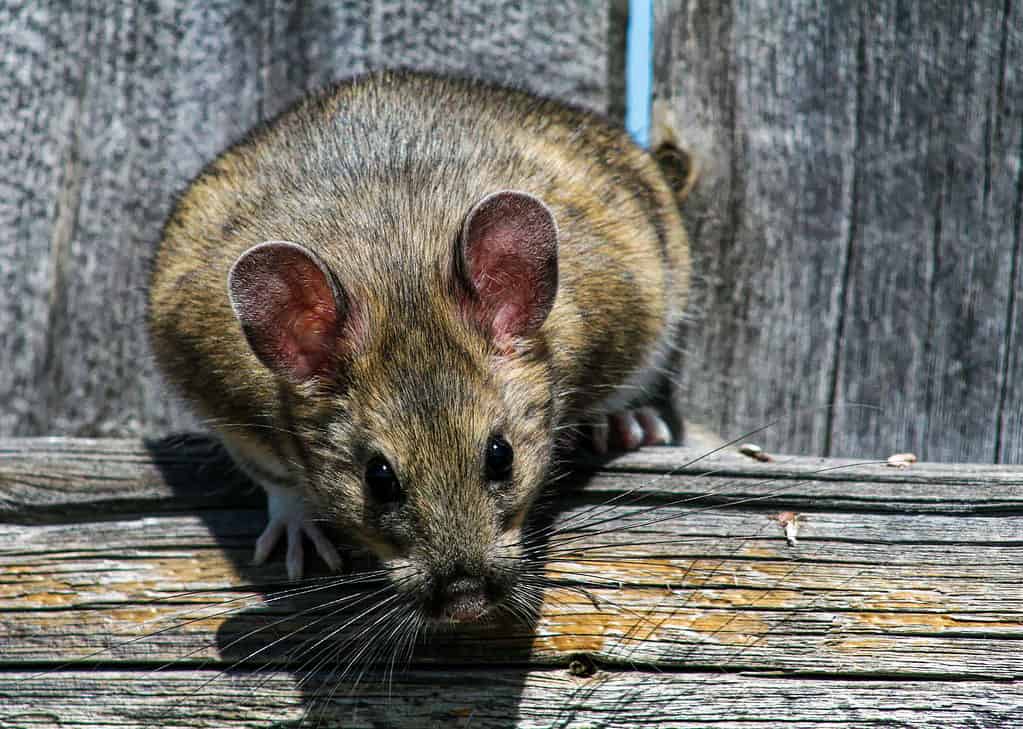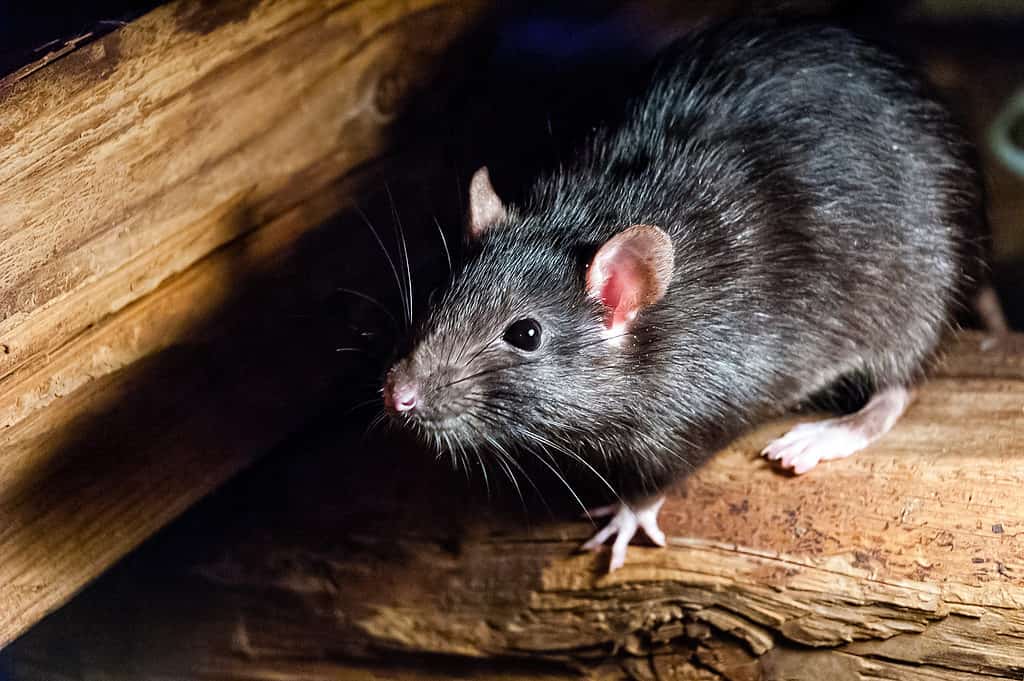Canada, known for its vast landscapes and friendly locals, might be the last place you’d expect to find a cast of colossal rats. But hold onto your cheese, folks, because we’re about to unveil the not-so-secret identities of the four largest rats in the Great White North.
Prepare to be amazed, amused, and perhaps squeamish as we dive headfirst into the world of oversized rats.
1. Muskrat

Muskrats may not be what
youimagine when you think of a rat, but they are the largest rat in Canada – though they aren’t “true” rats.
©YanLev/Shutterstock.com
- Length: 40-70 cm
- Weight: 0.7-1.8 kg
In Canada’s vast wetlands and waterways, a unique creature reigns supreme as the largest member of the rat family. Say hello to the muskrat (Ondatra zibethicus), a semi-aquatic marvel that boasts an intriguing blend of adaptability and intelligence. These rats are known for swimming through the plumbing and into people’s bathrooms, among other things.
As semi-aquatic animals, these rats typically live in aquatic habitats. Simply put, they like water. You’ll see them in marshes, ponds, lakes, and streams. They make their presence known everywhere. You’ll see them in Ontario, Manitoba, and British Columbia.
They can grow up to 16 inches and weigh up to 4 pounds, which is pretty sizeable for a rat. They have stout bodies and a very long, flattened tail. Their fur ranges from dark brown to reddish and is very waterproof. It provides excellent insulation for their aquatic activities. Their hind feet are webbed to provide extra propulsion in the water.
Despite being mammals, muskrats are aquatically adapted. They are very equipped to live in the water, making them very different from other rat species. Their aquatic nature may be one reason they are so large. The water provides the benefit of lessening the burden of gravity.
They are mostly nocturnal creatures, conducting their activities under darkness. They’re also solitary and will fiercely defend their territories from other muskrats. However, you’re unlikely to see them or even know one lives near you.
These herbivorous rodents have a voracious appetite for aquatic vegetation. Muskrats feed on various plant materials, including cattails, sedges, water lilies, and bulrushes. They’ll consume just about anything they can forage.
Muskrats gather to breed and may even share communal burrows during the breeding season. Females remain pregnant for about 30 days and give birth to up to 8 kits. They can do this several times a year, allowing the population to rise quickly.
2. Brown Rat

These rats eat
everything.
©iStock.com/MriyaWildlife
- Length: 30-50 cm
- Weight: 0.15-0.5 kg
Brown rats aren’t nearly as large as muskrats. However, they are the second-largest rat species in Canada, and you’re much more likely to see one.
The brown rat is one of the most common rodents in the world. Technically, this rat isn’t native to Canada. However, it hitched a ride on ships early on in the settling of the country – which is exactly how it spread worldwide.
They’ve made their presence known throughout Canada, particularly in urban areas where they have adapted to live. They have spread coast-to-coast and can live in just about any climate, especially when human activity has made life easier.
They can grow up to 10 inches in length, with up to an extra 8 inches from their tail. They’re very robust and compact, which allows them to thrive in city centers. They’re often brown to gray.
Brown rats are particularly adaptable. They are capable of living right next to humans, often without detection. They can reproduce rapidly and have a talent for finding shelter just about anywhere. Plus, they’re particularly adept at problem-solving.
They will consume almost anything, including grains, fruits, veggies, nuts, seeds, and insects. Their ability to exploit just about any food source has allowed them to thrive next to people.
Brown rats exhibit a social hierarchy, with dominant males and females leading the pack. They are known for their complex social interactions, forming family units and cohesive groups. This way, they’re a bit like the humans they live alongside.
3. Bushy-tailed Woodrat

Bushy-tailed woodrats are found in Canada and enjoy living in or around rocky places.
©M. Leonard Photography/Shutterstock.com
- Length: 30-50 cm
- Weight: 0.14-0.45 kg
The bushy-tailed woodrat is one of the few rat species that is native to Canada. It’s slightly smaller than the brown rat and doesn’t pose such a hygiene risk to humans. It prefers to live in the woods, as you might guess from its name.
This species needs dense vegetation and plenty of suitable nesting sites. They’re most common in coniferous forests, though they may live in mixed forests, too.
They build very elaborate homes called “middens,” which led to them being known for their construction skills. They construct these homes out of sticks, twigs, and whatever else they can find. Their middens are usually spherical with interconnected chambers and tunnels. They can reach up to 3 feet in diameter.
These middens provide the rat with a place to hide their food and other items, as well as protection from the elements.
Bushy-tailed woodrats are exclusively herbivores, meaning they only eat plants. However, they will consume various plants, including twigs, bark, and seeds. They may play a key role in dispersing seeds.
Like most rodents, this species is nocturnal and remains hidden during the day. Therefore, you’re unlikely to see them at all. They’re very crafty critters that prefer not to set up shop near humans.
Breeding among bushy-tailed woodrats occurs between late winter and early summer. Females, known as does, have a gestation period of approximately 30 days. They give birth to a small litter of one to five pups, born hairless and blind.
However, these pups developed rapidly and are on their own after a few months. Because these rats take slightly longer to develop than other species, the bushy-tailed woodrat doesn’t exactly breed like rats.
4. Black Rat

As you might expect, black rats are typically black.
©Carlos Aranguiz/Shutterstock.com
- Length: 16-24 cm
- Weight: 0.08-0.23 kg
The black rat is another holdover from Eurasia, likely a stowaway on some European boat centuries ago. As the last rat species on this list, the black rat is also the smallest. It won’t be breaking any records. black rats
Although less prevalent than the brown rat, the black rat tends to live in urban areas around ports and warehouses. It takes advantage of the abundant food and shelter humans provide in these areas. It’s mostly found in coastal regions and larger cities.
The black rat possesses a slender and agile body, measuring approximately 7 to 9 inches. They don’t weigh much, either. As the name suggests, they are mostly black but can also be dark brown.
Their tail is long and scaly, acting as a balancing tool for verticle movements.
The black rat is a very good climber. They’re known for scaling straight-up walls, pipes, and cables, so keeping them out of any space is challenging. Their small size allows them to escape through narrow openings, too. Therefore, they can be just as troublesome as black rats.
They can exploit a range of food options, including grains and vegetables. However, they are mostly herbivores.
These rats are nocturnal like most. They’re somewhat social, though, forming small family groups and colonies. They will breed throughout the year; a single female can produce several litters. Therefore, their population can explode very quickly.
Black rats have long been associated with potentially transmitting diseases to humans and other animals. They can act as carriers of various pathogens, including bacteria, viruses, and parasites, which may pose health risks. For this reason, urban cities often try to control their population.
Summary of the Largest Rats in Canada
| Number | Weight | Length | Species |
|---|---|---|---|
| 1 | 0.7-1.8 kg | 40-70 cm | Muskrat |
| 2 | 0.15-0.5 kg | 30-50 cm | Brown Rat |
| 3 | 0.14-0.45 kg | 30-50 cm | Bushy-tailed Woodrat |
| 4 | 0.08-0.23 kg | 16-24 cm | Black Rat |
The photo featured at the top of this post is © Anton MirMar/Shutterstock.com
Thank you for reading! Have some feedback for us? Contact the AZ Animals editorial team.







